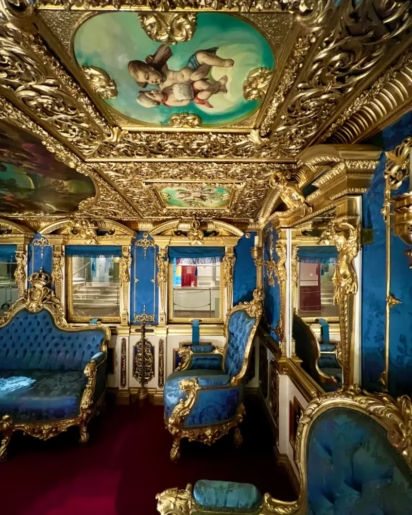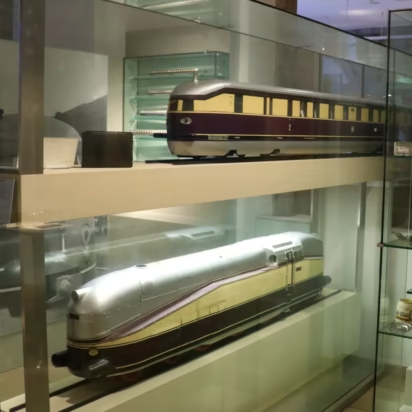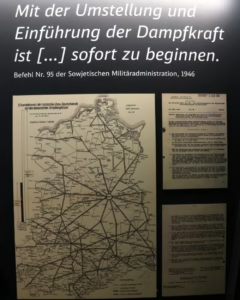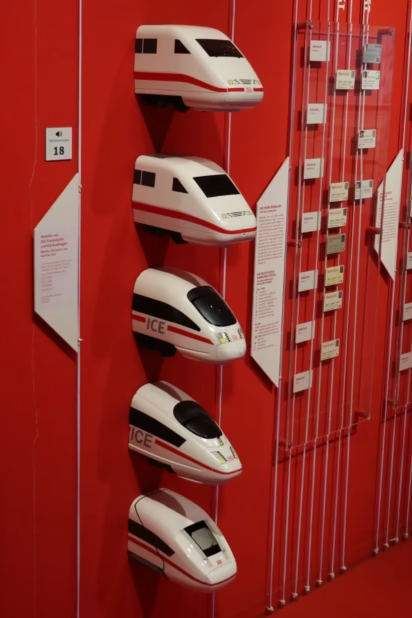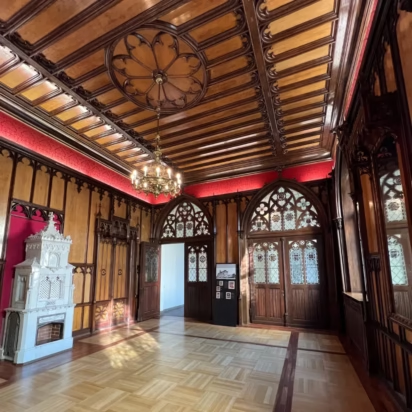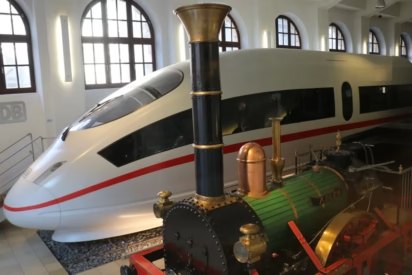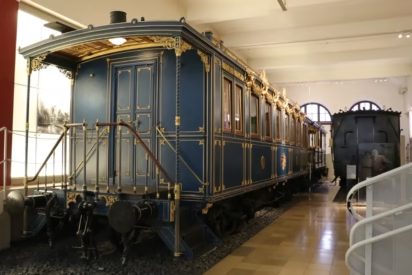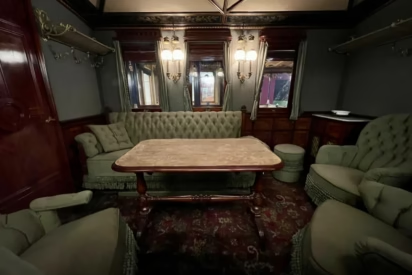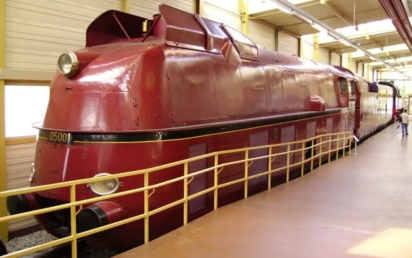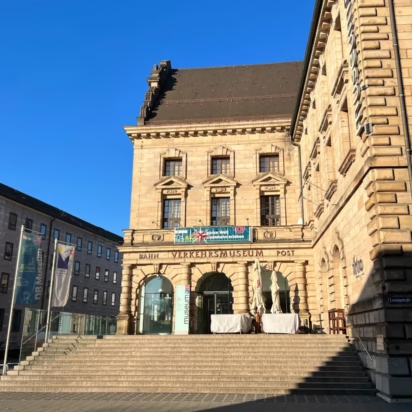Visit the DB Museum of German Railways in Nuremberg to see historic locomotives, wagons, and items related to trains in Germany.

The DB Museum in Nuremberg functions as the company museum of Deutsche Bahn (German Railways) but covers trains and railway transportation in Germany from the early 19th century to the present. The museum explains the development of the railways in Germany in chronological order and includes controversial events such as the transportation of Jews to concentration camps, wars, divisions, and the designs and models of trains that were never built. Only a small number of the around 150 historical trains are on display with the selection of trains changing usually annually. Together with the small Museum of Communication, the DB Museum form the Verkehrsmuseum (Transportation Museum) in Nürnberg. The Nürnberg City Card is valid.
DB Museum of German Railways in Nuremberg
The DB Museum in Nuremberg is the oldest railway museum in Germany and owns the largest collection of historic trains in the country (although only a small number of the 150 trains are on permanent display in Nürnberg). It is a fun museum and visitors of all ages will find things to enjoy whether particularly interesting in railways or not.
The exhibitions in the DB Museum are organized chronologically from the first railways in German states in the early 19th century to the present. It allows visitors to easily follow the development of the railways through the years — not only the technology of locomotives and trains but literally anything related to transportation on the rails.
The museum fully covers the role of railways in German history. Not only did the technology develop in the last almost two centuries, but also the whole framework of German politics, economy, and society changed (several times — often abruptly and dramatically).
Development of Railways in Germany

The first public passenger train on German-speaking soil connected Nuremberg and Fürth on 7 December 1835. The train was pulled by an English-built engine and dignitaries were amazed by the speed and comfort on the 6 km (3.7 mi), 20-minute journey. An accurate display copy of the “Adler” that pulled the train and an original passenger wagon are in the museum.
In the first half of the 19th century, Germany still consisted of many independent sovereign states. Similarly, many independent railway companies operated (but often did not directly compete) to provide services in the different states. Germany was unified in 1871 but only during the Weimar Republic did the Reichsbahn (RB) provide a single national service on most lines.
The railways played a major role in the industrialization of Germany but also provided vital transportation services during wars. The railways’ role in the transportation of Jews to concentration camps is explained in detail — ignoring it would be impossible in Nuremberg (vid. Nuremberg Trials Memorial and Reichsparteigelände).
After the Second World War, Germany and the railways were split into two and developed quite separately. Following re-unification in 1990, massive investment modernized the network. Budget cuts in the early 21st century contributed to Deutsche Bahn’s current performance deficits but the railways continue to modernize with interesting plans for mass transportation in the future.
Exhibitions and Highlights in the DB Museum Nürnberg

The highlights of the DB Museum in Nuremberg are for most visitors the historic trains (see below) but is worth seeing the main exhibition in the Verkehrsmuseum first before venturing outside.
The main exhibition themes and highlights in the DB Museum Nürnberg include:
1800-1848 — Early Development of Railways in Germany

- A coal wagon from 1829 — the oldest railway carriage on the European continent. (It was also horse-drawn where no locomotives were available)
- Personenwagen Nr 8 — the oldest surviving passenger railway wagon in Germany. It ran in 1835 between Nürnberg and Fürth.
1849-1919 — Industrialization and Unification of Germany. WWI
The demand for coal and steel for the railways helped fuel the rapid industrialization of Germany in the second half of the 19th century. Exhibits here include:
- An interactive map showing how railways in Germany grew from 6 km in 1835 to over 60,000 km at the outbreak of the First World War.
- A model of a fast re-coaling station to supply locomotives with new fuel with the least loss of productive time possible.
- Examples of the wares transported by railways and the need for new technology, such as a cooled railway tanker wagon to transport beer.
- Models showing how various classes of travel — first, second, and third class wagons reflected the different classes of society.
- The contribution of the railways in the first world war — around 14,000 railway personnel died during the war. In the first three weeks of the war, the German railway network transported amongst others in 11,100 trains 3.1 million soldiers, 860,000 horses, and countless ammunition and supplies to the front.
1920-1933 — The Weimar Republic and Foundation of the Reichsbahn

On 1 April 1920, the Reichsbahn replaced the former seven state railway companies to form a single national railway service. In addition to the single uniform that replaced the former seven, interesting displays here include:
- Rheingold advertising posters — from 1928 the fastest train from the North Sea to the Alps was popular with British travelers.
- Fliegender Hamburger (Flying Hamburger) — a model of the train that allowed Germany to develop a high-speed rail network in the 1930s. It operated at speeds of up to 160 km/h in normal service. (An original is often on display in the open-air area of the museum.)
1933-1945 — Nazi Era and Second World War
Several interesting displays on the railways during the Nazi era provide not only information on the railways but also an education on how Germany deals with a dark chapter in its history.
The Nazis dreamed and planned big — plans for the railways, which would be vital both in the development of the economy and in providing transportation in war, were in line with the egomaniacal fantasies of favorite architects and city planners.
Although the Flying Hamburger was developed earlier, it came into service shortly after the Nazis came to power. Further models and designs showed the fantastical trains they had in mind — double-decker trains almost 7 m high, 6 m wide, with a 3 m track gauge.

A large section deals with the role of the railways in the Second World War and especially the transportation of Jews, Sinit, Roma, and others to concentration camps. A suitcase from Auschwitz-Birkenau is displayed as a symbol of the Holocaust. A detailed explanation of the logistics needed in arranging a deportation train, including fake descriptions, showed the intricate details and planning that went into the whole operation.
Also on display are letters proudly claiming that despite seemingly insurmountable operational difficulties, the railways had worked out alternative plans and were able to transport 5,000 Jews daily to Treblinka concentration camp. Proceedings against senior railway personnel complicit in crimes against humanity were only really instigated in the 1960s with very limited prosecution or severe consequences.
1945-1949 — Destruction and Reconstruction
In the immediate aftermath of the Second World War, Germany was divided into four zones. France and especially the Soviet Union were keen to dismantle the railways. The Soviet Union transported as many trains, wagons, and infrastructure back home as war reparation and had the intention to entirely dismantle the electric railway system to return German trains to steam power. (The larger idea was briefly to change Germany back to an entirely agricultural economy.)
Note the four railway timetables for the four different zones — the French timetables forbid the use of the name Deutsche Reichsbahn.
1949-1989 — Germany and German Railways Divided
From 1949 to 1989, Germany was divided into two countries with the railways also split: the Deutsche Bundesbahn (federal railways) operated in West Germany (FDR) while the Reichsbahn continued to operate in the East (GDR).
In West Germany, cars were increasingly the preferred method for personal transportation despite the continued development of trains and a good railway system. In the GDR railways remained long the most important form of transportation, as cars were in chronic short supply and not available to average citizens. A 1:10 model shows a double-decker train that was developed in the GDR to increase transportation capacity without increasing train length.

Two competing international trains are also displayed in models:
- Model of the TEE Diesel Locomotive VT 11.5 in 1:10 scale. The Trans Europ Express (TEE) followed the specifications of a planned high-speed network in several European countries, which were ultimately not implemented on a European level. However, the TEE would be the typical luxury train of the West German railways until 1970s.
- Vindobona (1963) — to compete with the TEE, this train developed in the GDR was aimed at especially the export market and used on links such as Berlin to Vienna. It was in use until the 1980s.
Big railways projects in both East and West Germany were made especially in the 1980s. In the GDR, a rail ferry between GDR and Soviet Union was intended to avoid crossing through Poland in case of strikes.
In the West, the connection between Hannover and Würzburg was completed in the hope to make north-south travel competitive with cars. It was inaugurated in 1991 with the use of the first generation of ICE trains.
1990-2020 — Reunification & Deutsche Bahn
On 9 November 1989, the Wall came down and travel between East and West Germany became normalized. Germany reunited in 1990. The railways became just Deutsche Bahn (German Railways) in 1994 — a state-owned enterprise.
Massive investments were poured into railway and train development. Inner-German border crossing points fell from 44 at the end of the Second World War to only 9 in 1989. Train traveling time from Berlin to Nuremberg eventually improved from over 7 to less than 3 hours.
Models show all generations of the Inter City Express (ICE) trains from 1991 to the present. The first ICE 1 operated at speeds of up to 250 km/h while the ICE3 (2000) trains are the fastest and operate at up to 300 km/h. The latest ICE4 (2017) trains are somewhat slower (250 – 280 km/h) as the opportunities for top speed in Germany are too limited to justify the extra expense.
Waiting Room — Wartesaal für Allerhöchste Herrschaften
The wood paneling and neo-Gothic windows of a special waiting room ordered by King Maximilian in 1860 are on display in the museum — the designs of the Verkehrshausmuseum building specifically incorporated the neo-Gothic windows. This waiting room was reserved for the highest nobility (Allerhöchste Herrschaften).
The room was rarely used in period, as the special trains of the highest nobility (kings and princes of the realm) had preference and waiting was rarely required.
King Ludwig II used it at least once when he departed on a special tour of Franconia to encourage enthusiasm for Bavaria following the Prussian-Austrian War of 1866 when Bavaria backed the wrong side.
Model Railways / Modellarium

The DB Museum has more than 2000 model railways on display. These range in scale from 1:5 to 1:700 but the around 160 in 1:10 are particularly praised for accurate detailing.

The large model railway set of 80 m2 was built mostly in the 1960s and trains are steered on the 500 m of rails by around 5,000 relays. The 10-minute demonstration is usually hourly (starting on the half-hour). (The largest model train set in Germany is Mini Wunderland in Hamburg.)
Historic Trains and Locomotives in the DB Museum

The DB Museum has around 150 historic trains but only a few are on display in Nuremberg at any given time. The trains in the first hall I (Fahrzeughalle I) are fairly constant and always open with the rest of the museum. Trains in hall II (Fahrzeughalle II) and the open-air exhibition (Freigelände) change mostly annually and are not always accessible (especially during the winter months.) Far more historic trains are on display in the behemoth Technology Museum in Berlin.
Trains in Hall I of the German Railways Museum Nuremberg

The trains in Hall I are on permanent display and accessible from various rooms in the museum:
- Copy of the Adler, the first train that connected Nuremberg and Fürth in 1835. This exhibition copy was completed in 1952.
- Demonstration mock-up model of the ICE-3 train (1995) which reaches operating speeds of up to 300 km/h.
- Nordgau from 1853– the oldest surviving steam locomotive built in Germany.
- Bayrische Schnellzuglokomotive S 2/6 (1906) — in 1907, the S 2/6 set the world speed record for a steam train at 154.5 km/h — it lasted for 29 years. The drive wheels of 220 cm were impractical and with hardly any rails in Bavaria suitable for such speed, only the one research locomotive was ever built.
- Two Rococo trains of Bavarian King Ludwig II (1860s) — the opulent Versailles-on-Wheel (Salonwagen) and the Terrassenwagen with an open seating area. These trains were hardly ever used as Ludwig II increasingly withdrew from public view. (Ludwig II is famous for his fantasy castles including the ever-popular Schloss Neuschwanstein.)
- Salonwagen of Otto von Bismarck (1872) — this wagon was a (lobbying) gift to the “Blood and Steel” Reichskanzler (chancellor) Otto von Bismarck. He mostly used it for private travel from Berlin to his property near Hamburg — the wagon would simply attach to a regular fast train (but of course scheduled an extra stop wherever Bismarck wanted to get off).
Trains in Hall II of the German Railways Museum Nuremberg
Hall II is often only accessible when the general open-air museum area is open. The following three trains are usually on display while further trains and locomotives here and on open-air tracks rotate annually:
- Schnellzuglokomotive 05 001 (1935) — the aerodynamic appearance of some of the heaviest steam locomotives ever built. The aerodynamic covers turned out not particularly effective and were removed from trains after 1945.
- „Fliegender Hamburger“ (Flying Hamburger) (1931) — the predecessor of the ICE and foundation of the high-speed network in the 1930s. The diesel train (VT 877 a/b) connected Hamburg and Berlin in 2:18 with an average speed of 125.6 km/h.
- ICE4 Mock-Up Demonstration model (2011) — the new train operated at reduced speeds of up to 250 km/h compared to the 300 km/h of the earlier ICE 3 (on the few stretches of track long and straight enough).
DB Museum of German Railways Visitors Information

The DB Museum (German Railways) is the main museum in the Verkehrsmuseum building in Nuremberg. On the top floor, a handful of rooms form the Museum für Kommunkation (Communication). Far larger communication museums in Germany are in Frankfurt and Berlin.
Kibala — a large area especially for smaller children is also on the top floor. Admission to both museums is included in the basic museum ticket.
DB German Railways Museum Nuremberg Opening Hours
The DB Museum is open Tuesday to Friday from 9:00 to 17:00 and weekends and some public holidays from 10:00 to 18:00.
The open-air section of the museum is often closed from November to April.
The German Railways museum is open on Easter and Pentecost Monday but is closed on January 1, Good Friday, May 1, December 24, 25, and 31.
Ticket Prices for the DB Museum in Nuremberg
Admission tickets for the DB Museum are €9 (€5 for children 6 to 17 years). Family tickets for two adults and up to four children are €18. Tickets include admission to the whole Verkehrsmuseum building including the Museum of Communication. The Nürnberg City Card is valid.
Small discounts are given if arriving with a valid DB or VGN (local public transportation) ticket.
Transportation to the DB German Railways Museum Nuremberg
The DB Museum Nürnberg, Lessingstraße 6, 90443 Nuremberg, is just outside the old town walls of the city center a few minutes walk from the Hauptbahnhof (follow DB Museum signs to the side entrance). If traveling by metro, U-Bahn station Opernhaus (U2 and U3) is only a two-minute walk from the Verkehrsmuseum. The museum is also very close to the Germanisches Nationalmuseum.
Nürnberg City Card: Save on Sightseeing in Nuremberg
Two discount deals are worth considering to save on sightseeing when visiting Nuremberg (Nürnberg):

A day ticket valid for admission to all Nuremberg city municipal museums is €10.50 and gives admission to the Albrecht-Dürer-Haus, Museum Tucherschloss und Hirsvogelsaal, Stadtmuseum Fembo-Haus, Spielzeugmuseum (Toys), Museum Industriekultur, Nuremberg Trial Memorial, and the Dokumentationszentrum Reichsparteigelände. It is available from all participating museums.
The Nürnberg City Card is around €33 and covers all public transportation in Nuremberg and Fürth for 48 hours. It gives free admission to the Imperial Castle Nuremberg (Kaiserburg), Deutsches Museum Nuremberg, Germanisches Nationalmuseum, Albrecht Dürer House, Neues Museum, Toy Museum, Documentation Center Nazi Party Rally Grounds Interim Exhibit (main exhibition closed until 2025), Memorium Nuremberg Trials, DB Museum (German Railways Museum), Museum for Communication, Museum of Industrial Culture with the School Museum, City Museum at Fembo House Permanent Exhibit: A Crown – Power – History, Museum Tucher Mansion, Bavarian Bible Museum, Museum of Natural History, towerofthesenses, Kunsthalle Nuremberg, Kunstvilla Nuremberg, Kunsthaus Nuremberg, Museum Executioner’s House, Zoo Nuremberg, Children’s Museum, Red Cross Museum, Motor Museum Merk, Faber-Castell Stately Home with the Museum “Alte Mine”, Bratwurst Museum, Jewish Museum Franconia, Fürth, City Museum Fürth, and Ludwig Erhard Center Fürth. It also gives savings on guided tours and further events.
More on Traveling to Nürnberg:

More resources for planning travel to Nuremberg in Bavaria, Germany:
- Buy a Nürnberg City Card to save on sightseeing and transportation.
- Top Sights to See in Nuremberg:
- Visit the Nuremberg Trials Memorial (Courtroom 600)
- Reichsparteitagsgelände (Nazi Party Rally Grounds)
- Visit the Germanisches Nationalmuseum — the largest cultural history museum in Germany.
- Visit the Kaiserburg — Imperial Castle in Nuremberg
- Visit the Albrecht-Dürer-Haus Museum where the artist lived and worked for two decades.
- Visit the DB German Railways Museum
- Visit the Nuremberg Christmas Market (Nürnberger Christkindlesmarkt)
- Transportation to Nuremberg in Bavaria
- Traveling by Train to Nuremberg – German Railways Timetables to Nuremberg
- Book Flights on Lufthansa, KLM, or Air France.
- Cheap Flights to Nuremberg Airport (NUE)
- Transportation to Nuremberg Airport (NUE)
- Transportation from Munich Airport (MUC) to Nuremberg
- Nuremberg hotels are generally less pricey than those in Frankfurt or Munich.
- Adidas Factory Outlet Stores — half an hour north of Nuremberg but a very popular stop en route to Bamberg.
- Suntransfers give online quotations without requiring flight and personal details.
